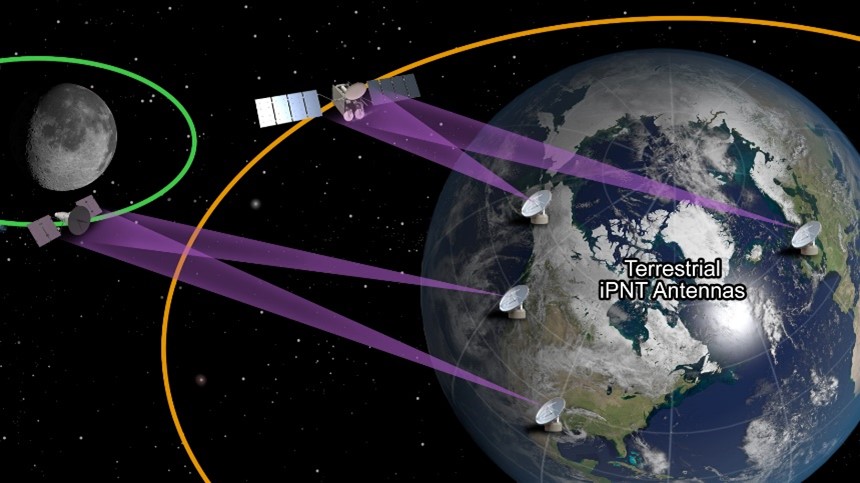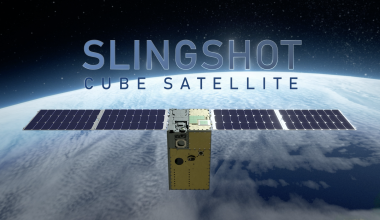Position, Navigation, and Timing (PNT) services in space are vital for actions such as maneuvering, formation flying, collision avoidance and constellation operations. The Global Positioning System (GPS) is crucial to terrestrial and much of today’s spacecraft navigation. But for cislunar space, a PNT solution that could simultaneously service many missions is not yet in place.
Government and commercial operators are looking to fly beyond Earth’s geosynchronous orbit (GEO) belt into cislunar space for a range of new missions. Enabling such space operations requires a reliable PNT service. The Aerospace Corporation is meeting this need with a system called Inverted PNT (iPNT).
Designing the Navigation Framework for Cislunar Missions
“Here in the third decade of the 21st century, we have arrived at a point where U.S. and international organizations routinely operate beyond the GEO belt,” said Dr. Roberta Ewart, S5 Strategic Technical Advisor, Space Systems Command. “Motivations include science, commerce and advancing national interests. Operating at these distances creates a need for simple, scalable navigation systems. We also see a future where shared interests helps assure freedom of space navigation for government, science and commercial actors alike. Partnering on shared infrastructure is one way to bring about that future.”
Andre Doumitt, Systems Director in Aerospace’s Commercial Space Futures Office, initiated the project based on a concept created by Dr. Tom Heinsheimer, Member of Technical Staff in Aerospace’s Civil Systems Group Development Directorate. The iPNT design was built on the foundation of an Aerospace study that examined future cislunar missions and the architectural support necessary to meet customers’ objectives. The conclusion of the internal study resulted in a call for mission-enabling PNT.
“There has been much investigation into how exquisite cislunar PNT services could be delivered with huge, complex, and costly architectures like GPS,” said Dr. Todd Sheerin, Senior Project Engineer in Aerospace’s Advanced Development and Planning Division. “Our team, inspired by Dr. Heinsheimer, approached this challenge with a different mindset: What solution can we offer that would be extremely low cost, could be implemented in the near term, and work with existing technologies and infrastructure to the maximum extent?”
Building the Cislunar Future
Leveraging the information gained from the team’s variety of studies, Aerospace defined the performance metrics that a PNT system would need to meet to support upcoming cislunar missions. These guidelines ultimately influenced the design of the initial iPNT concept. Unlike GPS, which broadcasts signals from space to Earth, the iPNT concept broadcasts signals from ground stations to spacecraft flying in cislunar space. This inversion of the traditional architecture provides multiple advantages.

Initial deployment can be accomplished using commercial antennas at existing ground stations, greatly reducing cost while simultaneously allowing for easy scalability. These PNT services could also be tailored to the needs of a given mission by the frequency and duration of the transmissions to ensure accuracies meet mission thresholds. Furthermore, providing PNT via targeted transmissions avoids the interference problems a traditional blanket broadcast method would pose.
Cross-functional and interdisciplinary teams came together to further advance the concept, developing the cislunar PNT requirements, performing modeling, simulation and development of the baseline architecture, and designing an AI-based approach for iPNT to manage higher volumes of cislunar traffic.
The present development phase is the detailed design of a low size, weight and power (SWaP) CubeSat-compatible configuration that can fly on an Aerospace CubeSat and be available to government and commercial spacefarers. By reaching this stage in development, iPNT is one step closer to becoming a commercially run, ubiquitously available system for spacecraft operating in, or transiting through, cislunar space.
“Based on our analysis work so far, and expert feedback from the technical papers we have published, we are seeing promising iPNT performance results and the team is excited how this approach can support many cislunar activities,” said Rina Onishi, Member of Technical Staff in Aerospace’s Vehicle Design and Innovation Department. “Our iPNT concept has value in terms of availability, reliability and resiliency.”
This architecture provides a number of options for commercial participation: use of the iPNT spacecraft design IP for commercial flights, use of commercial ground antennas for uploading of iPNT signals, and operation and management of the iPNT ground hub. Anyone interested in flying or adapting the Aerospace iPNT design to any cislunar mission, is invited to contact Aerospace for further discussions.





